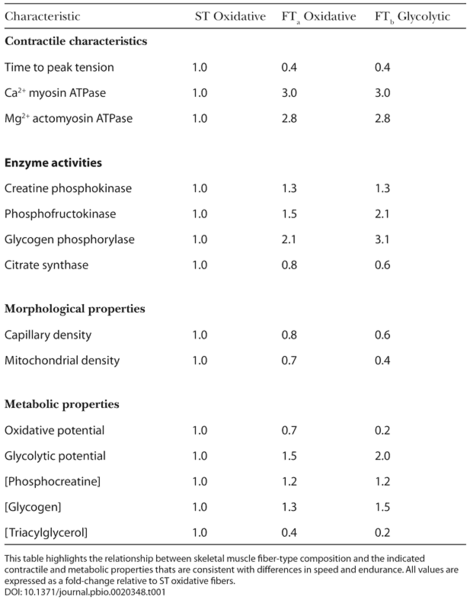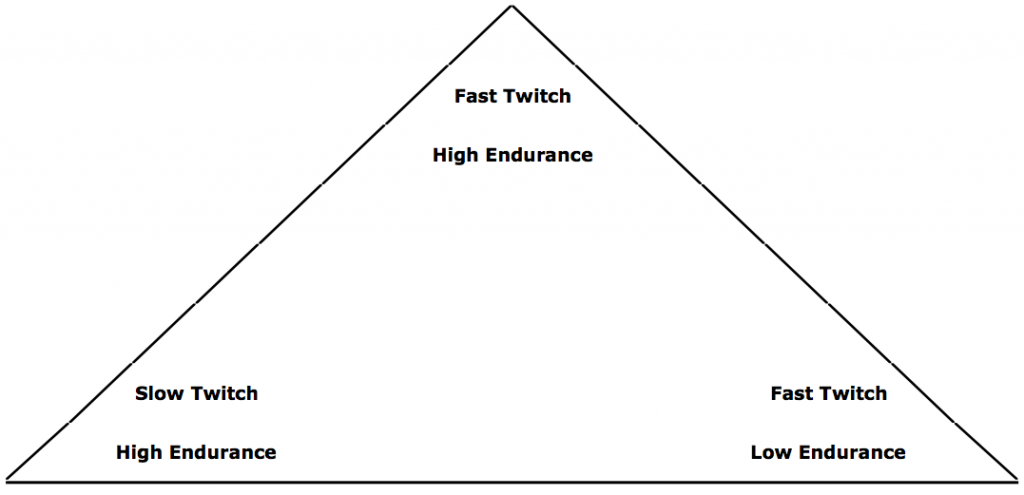When I was an undergrad at the University of Delaware, we, like most undergrads in exercise science or related fields, learned about different muscle fiber types. This is important information as different muscle fibers lend themselves to different tasks. As a very quick over-simplified example, some are more endurance-based and others are more strength- or power-based.
While some mild adaptations have been made to this model since I first learned it, in general muscle fibers are broken down into one of three categories: Type I Slow-Twitch (Oxidative), Type IIa Fast-Twitch (Oxidative), or Type IIb Fast-Twitch (Glyolytic). While there are multiple ways of classifying or characterizing muscle fiber types (contractile, enzymatic, structural, and metabolic characteristics), all of these things are inter-related and it would therefore be, for our purposes today, superfluous to go into extensive details on each.

An example breakdown of muscle fiber characteristics
The general consensus is that, based largely on genetic make-up, each of us has a certain percentage of slow twitch, fast twitch, and transitional muscle fibers. The transitional fibers are “trainable”, meaning that they can adapt to the stresses we place across them to become more slow- or fast-twitch-like. Another inherent message in this system is that, no matter what you do, there are fibers whose characteristics cannot be changed.
As you may have guessed, I have some questions about this way of viewing muscle fibers.
First, no discussion on muscle fibers would be complete without mention of motor neurons. A motor neuron is what drives a muscle fiber to contract. In other words, muscle fibers are somewhat useless if they’re disconnected from a motor neuron (still can generate passive tension, but nothing active…at least until they’re re-innervated). There is also some evidence that it’s the motor neuron that determines the muscle fibers contractile characteristics. For instance, an old study on cats showed that when the experimenters took a fast twitch motor neuron and connected it to a slow twitch muscle fiber, and vice versa, the slow twitch muscle fiber started to behave with fast twitch characteristics, and the fast twitch muscle fiber behaved with slow twitch characteristics. Basically, fast and slow twitch muscle fibers switched behavior in response to having their neural inputs switched.
Moreover, it is well established that motor neurons are recruited in order from smallest to largest, which recruits muscle fibers from “least strong” to “most strong” (an oversimplification, but illustrative of the point). With these things in mind, I’m surprised that we’re still viewing muscle fibers in these “buckets” of EITHER Type Ia, Type IIa, or Type IIb. I’m aware that researchers are beginning to “discover” Type IIc and Type IIx fibers, but are we missing the big picture?
Opposed to describing set muscle fiber types, wouldn’t it be more accurate to describe muscle fibers as exhibiting characteristics along a continuum ranging from PURELY slow twitch/high endurance to fast twitch/low endurance? And if there are indeed muscle fibers that exhibit fast twitch AND high endurance characteristics, maybe the continuum’s shape will change from something linear to something more triangular?

A new view on muscle fiber characterization
The neuromuscular system is HIGHLY plastic, meaning adaptable to training (and living) demands. The idea that we have muscle fibers that “cannot be transformed” ignores the fact that we would never want to have PURELY “Type I” or “Type IIa” fibers. Think of the implications of this. When we stand, there are dozens of muscles, including those of the circulatory and respiratory systems, that are tonically (read: constantly) active at low levels, sufficient to keep us breathing, oxygenated, and from falling. These muscles require at least some of their muscle fibers (and again-muscle fibers in this context is just another way of saying “motor unit” or the motor neuron and connected muscle fibers) to exhibit Type I characteristics. Death is the alternative. This means that, even for the sports/activities that are the MOST fast-twitch dominant (e.g. powerlifting, Olympic lifting, shotput, javelin, etc.), the athlete will need a combination of fast- and slow-twitch fibers to stay alive. It also means that, during everyday life, EVERY living human is creating a reinforcing stimulus for these Type I fibers. In other words, it’s not that they aren’t “trainable”; it’s that they’re constantly being fed a stimulus to remain exactly as they are.
The same can be said for endurance-based athletes. There are times when contractions necessitating higher force levels are advantageous for health and performance (e.g. quickly adapting to unpredictable ground changes or overall perturbations via stretch-reflex mechanisms), and every time the body needs to produce high amounts of force, it’s creating a stimulus to the body to maintain high force levels. Interestingly, during immobilization, where some of the tonic postural maintenance roles of the involved musculature is diminished, there is some evidence that muscles will lose some of their Type I characteristics (Hortobagyi et al., 2000).
I think we’ve both over-complicated and misrepresented the characteristics of the neuromuscular system.

A live webcam shot of David Lasnier reading this post…from his new computer
As I mentioned, the body is highly adaptable to the stimuli we present it. In this regard, it may not be that certain muscle fibers are “untrainable”, it may be that we need to expand our view on what we consider “training”. Training, realistically, is EVERYTHING we do, as every movement or lack thereof is creating some stimulus of adaptation (for better or worse) to our bodies. And because the stimuli we constantly provide inevitably varies with regards to the force and endurance characteristics, our neuromuscular system has created a CONTINUUM of motor neuron/muscle fiber characteristics to cater to our needs as humans and as athletes. Inevitably, these adaptations have occurred throughout the history of mankind via DNA alteration processes, and more acutely via inter-lifetime adaptations to imparted stimuli.
To your success,
Kevin Neeld
Reference:
Hortobagyi, T., Dempsey, L., Fraser, D., et al. (2000). Changes in muscle strength, muscle fibre size and myofibrillar gene expression after immobilization and retraining in humans. Journal of Physiology, 524, 293-304.